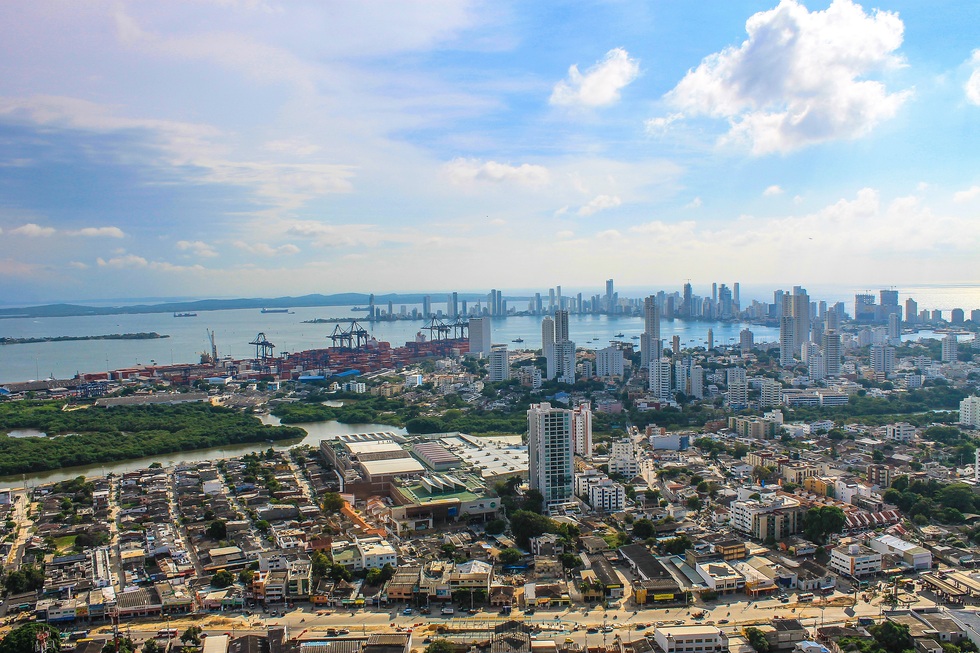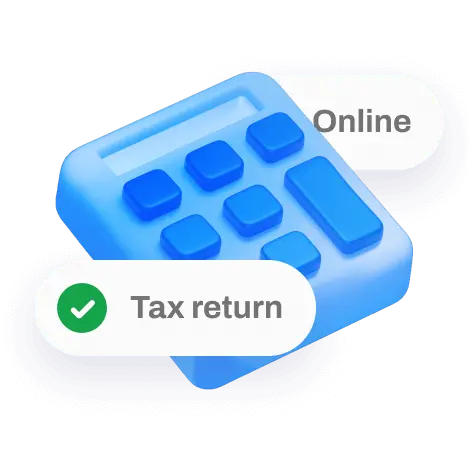Can Americans buy property in Colombia? A complete guide for 2026

Colombia’s stunning landscapes, affordable living, and welcoming atmosphere have turned it into a favorite among Americans buying property in Colombia for lifestyle or investment. In 2024 alone, the country welcomed a record-breaking 6.7 million visitors, highlighting its growing appeal to international travellers. Meanwhile, the 2025 minimum wage of COP1,423,500 signals a stable and evolving economic backdrop for foreign investment, especially in the real estate sector.
This article is brought to you by Taxes for Expats – a top-rated team helping Americans abroad meet US filing requirements. If you’re looking to buy property in Colombia as a US citizen, we can guide you in staying compliant with the IRS after purchase.
Can Americans legally own property in Colombia?
For Americans, the path to real estate ownership in Colombia is remarkably straightforward – the law gives them the same rights as locals, making buying property in Colombia a transparent process. Colombia’s Constitution guarantees equal civil rights, so a foreigner can acquire, hold, and transfer real estate without residency or special approval.
The title is perfected by a public deed and registration with the Public Instruments Registry under the Superintendence of Notary and Registry. Below are the main points that clarify how rights for a foreigner compare with those of Colombian citizens:
-
Equal rights with locals: Foreign buyers face no added restrictions compared to Colombian citizens – the process, fees, and protections are identical.
-
Residency not required: A foreigner can purchase a property without holding a visa; the investor visa is simply an option if you want long-term stay benefits.
-
Universal land rules apply: Restrictions exist only on collective or protected lands, and those apply equally to nationals and foreigners.
NOTE! Foreign buyers are free to acquire urban apartments, suburban houses, or rural parcels with a clear private title – your home in Colombia is legally secure once you properly register it. The only exceptions are untitled baldíos (state lands) and collective territories such as indigenous resguardos or Afro-Colombian community lands, which cannot be privately transferred. For all other titled properties, the rules ensure clarity, security, and equal treatment.
Legal documents – needed before you acquire properties
Before you buy property in Colombia, assemble a tight file that satisfies notaries, registries, and banks. These same papers below speed due diligence, FX registration, visas, and any future plans in real estate.
-
Passport and Colombian Tax ID (NIT). Bring a valid passport. Register for a RUT with DIAN to obtain a NIT – the process is free, and foreigners can apply from abroad via DIAN’s online PQSR channel.
-
Proof of funds or financial documents. Expect banks/notaries to ask for bank statements and source-of-funds to channel money through the exchange market. Register incoming capital as foreign investment with Banco de la República – this protects repatriation rights, and registration must be filed within 12 months of the operation.
-
Property-specific certificates (title, cadastral, no-debt). Order the Certificado de Tradición y Libertad for the folio – it costs about COP 35,900 (mid-2025) online and is valid for 30 days. Get the cadastral certificate from IGAC’s portal (free) and download paz y salvo/property-tax payment certificates via the city’s virtual office (e.g., Bogotá).
-
Any legal or administrative permits. If you’ll host short-term stays, register in the Registro Nacional de Turismo (RNT) – it’s mandatory and free. MinCIT notes the RNT must be active before offering lodging services.
If you’re wondering where and how you’d get the above documents, apply for the RUT/NIT with DIAN; pull the title certificate from Supernotariado; request cadastral records from IGAC or your local gestor catastral; generate tax paz y salvo in your municipality’s virtual office; and file investment registration in Banco de la República’s SIC system. With these in hand, a US citizen can move smoothly from paperwork to closing as they buy property in Colombia.

Colombia property prices – 2025 snapshot
Latest data shows what your budget buys across Colombia’s flagship cities – and what shifts as you move from city-centre towers to suburban, low-rise areas. If you plan to buy property in Colombia as an American, take note, as these numbers set up the rest of the guide on mortgages, visa thresholds, taxes, and rental strategy.
Average purchase prices by city
The table below uses Numbeo’s 2025 real estate figures, with outside-centre apartment prices serving as a realistic stand-in for houses, all converted into COP per square meter for easy reference.
| City/region | Apartment – city centre (COP/m) | House/Outside city centre (COP/m) |
|---|---|---|
| Bogotá (Capital) | ≈7,510,000 | ≈5,360,000 |
| Medellín (Antioquia) | ≈7,640,000 | ≈5,600,000 |
| Cali (Valle del Cauca) | ≈4,080,000 | ≈3,270,000 |
| Barranquilla (Atlántico) | ≈4,330,000 | ≈2,830,000 |
| Cartagena (Caribbean) | ≈11,000,000 | ≈11,300,000 |
| Bucaramanga (Santander) | ≈5,230,000 | ≈4,470,000 |
| Santa Marta (Magdalena) | ≈7,330,000 | ≈3,680,000 |
| Pereira (Coffee Region) | ≈4,900,000 | ≈3,200,000 |
Even with the prices in Colombia’s top-tier markets displayed in the table above, they still fall below typical property prices in the US, where city-centre real estate averages around $3,248 per square meter and suburban areas hover near $2,726. Even in Bogotá or Medellín, prime central listings are often a fraction of what a comparable space costs in major American metro areas.
This price gap opens the door to significantly better value per square meter, especially when you consider the factors that directly influence how much a home will cost in Colombia:
-
Location shapes price the most – beachfronts, historic districts, and tourist hubs push values up, while outer neighborhoods stay more affordable.
-
Size plays a role – larger homes often offer lower costs per square meter, while compact units in prime areas can be priced at a premium.
-
Condition matters – new or renovated properties with amenities, security, or views typically sell for more than older, unmodernized stock.
Key steps to purchasing a property in Colombia
Acquiring Colombian properties is a structured, regulated process open to both residents and non-residents. Since foreigners buy property in Colombia under the same legal framework as locals, the steps below explain how Americans can secure title – from market research through closing and registration – while linking to critical parts of this broader guide, including taxes, visas, and legal due diligence.
Step 1: Research the market and set a budget
Start by reviewing recent sales in your preferred cities – Medellín for digital nomads, Bogotá for professionals, Cartagena for vacation rentals. As an American buyer, you should plan for closing costs like ≈0.54% in notary fees and 0.5–1% in registration tax, both based on deed value and location.
Step 2: Find a property through a real estate agent or online platforms
Work with a bilingual real estate agent who understands foreign buyers' needs and access sites like FincaRaiz or Metrocuadrado to compare listings. For instance, a furnished two-bedroom in Laureles (Medellín) might come with HOA rules that prohibit short-term rentals – vital info if you plan to Airbnb.
Step 3: Make an offer
Once you’ve found a fit, submit a written offer that outlines price, deposit amount, and which party covers closing fees. Expect the seller to counter, and know that negotiation is part of the process – especially if there are repairs or permits still pending.
Step 4: Sign the Promesa de Compraventa (preliminary sales agreement)
This enforceable contract outlines all the transaction terms, including the deposit amount, penalties, and a deadline to sign the final deed. It's a legal bridge to closing and protects both buyer and seller if either backs out improperly.
Step 5: Conduct due diligence (verify title, debts, legal status)
Hire a local attorney to review the full Certificado de Tradición y Libertad for the property. Confirm that the title is clear of liens, tax debts, and that utility bills and HOA fees are fully paid. One common pitfall: a foreign buyer falls in love with a beach property in Santa Marta, only to find it's under restriction as protected land – not zoned for private sale, so ensure all due diligence is carried out.
Step 6: Obtain a Colombian Tax ID (NIT) and open a local bank account
Register with DIAN to get a RUT (tax ID), which becomes your NIT for property purchases. A Colombian bank account may also be required to handle local payments or rental proceeds.
Step 7: Transfer funds in compliance with currency regulations
Wire your funds through Colombia’s official exchange market and ensure the amount is registered as a foreign investment in real estate. This protects your right to repatriate profits and supports investor visa eligibility.
Step 8: Sign the Escritura Pública (public deed) at a notary
Both parties sign the public deed in the presence of a notary, who verifies documents and processes taxes and legal fees. Bring your passport, NIT, and any required authorizations if signing by power of attorney.
Step 9: Register the property with the local registry
The signed deed is submitted to the Oficina de Registro de Instrumentos Públicos, which updates the official folio. Registration legally confirms your ownership and completes the real estate transaction.
Best Colombian cities for property buyers
If you’re looking to buy a house in Colombia, the right city can tilt returns, livability, and risk in your favor. Which leads to the concise profiles below – tying population, culture, safety, and amenities directly to property potential.
Bogotá – national nerve center & commercial anchor
Home to about 7.94 million people (2025 projection), Bogotá concentrates corporate jobs, universities, museums, and the country’s busiest air hub, El Dorado – a connectivity boost that underpins rental demand and resale liquidity. The city is investing in security even after 1,204 homicides in 2024 (≈15 per 100,000), so higher-service buildings and well-managed strata in Chapinero/Usaquén tend to defend yields as expats cluster near work and transit. Americans can purchase freely here; the notary-to-registry closing path is standard for foreign buyers.
Medellín – perennial-spring climate & innovation engine
With ≈2.63 million residents (city) and a metro of >4 million, Medellín’s culture is outdoorsy and neighborly, and the Metro + Metrocable system keeps prime areas connected – helpful for furnished rentals. The estimated 2024 homicide rate of ≈11/100,000 marked a multi-decade low, which, alongside steady tourism and healthcare access, supports stable absorption in El Poblado/Laureles. Foreign ownership is straightforward, and developer inventory plus modern amenities make closings smooth.
Santa Marta – beaches & wild-park gateway
Known for Tayrona National Natural Park access, Santa Marta (pop ≈566,650) offers lower buy-ins than Cartagena while still drawing holiday demand. Homicide data for 2024 is contested – an NGO listed 45.24/100,000, while the city cited 34.5/100,000 – so favor secure condos near Simón Bolívar Airport for liquidity and management ease.
-
Amenities: beach districts + airport with 3.7 million passengers in 2024 – useful for occupancy and exit options.
-
Property angle: budget-friendly pre-construction can work, but enforce building bylaws and tourist-rental registration early.
Cartagena – seaside heritage & tourism magnet
Population ≈1.07 million (2025) and a UNESCO-listed walled center keep real estate demand strong for short-stay and luxury stock; Rafael Núñez Airport handled ≈7.5 million passengers in 2024, sustaining year-round visitor flow. Security remains mixed – 411 homicides in 2024 – so buildings with strict guest policies and 24/7 reception typically command premiums and smoother permitting for tourist rentals. Americans can buy on equal terms with locals; coastal HOA rules and RNT compliance are the gating items for investor-hosts.
Bucaramanga & rising secondary markets – value plays with green space
Often called the City of Parks, Bucaramanga (city pop ≈623,881; metro ≈1.2m) pairs universities and healthcare with calmer streets than big coastal hubs, translating to steadier long-term tenants. Recent reports show declines in theft and a homicide rate of ≈21/100,000 (2024), supporting conservative cash-flow models; entry prices are lighter than Bogotá/Cartagena for similar unit sizes. For Americans, the same foreign-friendly purchase rules apply – making Bucaramanga, Pereira, and the Coffee Region practical diversification picks.
Taxes that shape your Colombian real estate deal
If you want to buy land or a finished home in Colombia in 2025, your bottom line hinges on which taxes hit at purchase and which recur each year. The following shows clear, quick rules you can budget around.
-
VAT (IVA) on the purchase: Sales of real estate do not generate IVA in Colombia (post–Dec 28, 2018). Expect 0% IVA on the property price itself; IVA may apply to related services (e.g., commercial leasing), not the sale.
-
Registration tax at closing: The Impuesto de Registro is typically 0.5%–1.0% of the deeded value, set by each department and paid upon recording the deed.
-
Annual property tax (Predial): A municipal tax on the cadastral value, commonly within 1–16 per mil (0.1%–1.6%), with exact bands fixed by local councils; cities publish 2025 calendars and discounts for prompt payment.
NOTE! If you’re an American buyer, after paying Colombian taxes, you still must report to the IRS – report any rental income on Schedule E and typically claim the Foreign Tax Credit on Form 1116; accounts you use in Colombia may also trigger FBAR. Foreign real estate held directly isn’t reported on Form 8938, but foreign accounts are, when thresholds are met.
Also read. Understanding taxes in Colombia
Fees and extra costs most buyers face in 2025
Owning property in Colombia also comes with non-tax costs you should price in from day one. Which leads to the below – lean ranges so expats can budget fast and adjust for building and city.
| Cost item | Typical range | Notes |
|---|---|---|
| Notary (escritura) fee | ≈0.54% total (often ≈0.27% buyer share) | Standard deed fee, commonly split; add ≈0.27%–0.30% if a mortgage is executed. |
| Legal counsel/title review | ≈0.1%–1.0% of price (or fixed COP fee) | Market-based; example title-study fees scale with price. |
| Building HOA/administration | Rule-of-thumb ≈0.3%–0.8%/yr of value (paid monthly) | Budget driver varies by building coeficiente de copropiedad; real-world amounts often COP 230k–500k+/month in larger cities. |
| Home insurance | ≈0.1%–0.3%/yr of insured value | Colombian press cites ≈1.5 typical premiums. |
Ranges are planning estimates; confirm your notary’s tariff table and your building’s approved 2025 budget. Cities revise registry/notary tariffs annually. For seasoned expats, these snapshots keep surprises low and negotiations sharp – then tailor to your target city and building rules.

American buyers – financing options for Colombian properties
Buying property in Colombia requires not only due diligence and legal prep, but a smart funding strategy that aligns with your visa, tax, and FX registration goals.
Colombian mortgages are technically open to foreigners, but access is limited. Banks typically require a cédula de extranjería, local income proof, and an established credit profile. While some institutions advertise up to 70% loan-to-value for qualifying clients, most expats won't meet the lending criteria.
Cash remains the most practical route for securing property in Colombia. It reduces delays, avoids mortgage paperwork, and ensures smoother foreign investment registration. For many expats, it’s also easier to leverage US home equity, take out a refinance loan, or negotiate staged payment plans directly with developers.
Residency via investment – rules in 2025
The real-estate investor route is the Migrant Visa (Type M) tied to a property purchase. Thresholds are indexed to the monthly minimum wage, so amounts reset each January.
-
Minimum investment: buy property worth ≥ 350 SMLMV and ensure your funds are registered as foreign investment with Banco de la República (you’ll need that bank certificate). With the 2025 SMLMV at COP 1,423,500, that’s COP 498,225,000.
-
Core paperwork cue: title certificate (Certificado de Tradición y Libertad) plus the foreign-investment registration confirmation tied to your name and the property.
Validity, renewals – path to residency
Plan your stays and renewals so you don’t break eligibility, which leads to the below key timers and options. Keep proof that you maintained the investment for every subsequent application.
-
Validity & presence: the M Investor visa is valid up to 3 years. If you’re absent >180 days in any 365-day window, the M visa can terminate automatically.
-
Renewal test: on reapplying, you must prove the investment remained in place for the full prior visa term.
-
Path to permanent residency (Type R) by time: hold qualifying M status for 5 continuous years, then apply for Resident (R).
-
Direct R by investment (alternative): you may also qualify for R – Foreign Direct Investment with >650 SMLMV (≈ COP 925,275,000 in 2025). R is indefinite, though authorities require a five-year traspaso re-issuance of the visa label.
Scam-proof your purchase: a US buyer checklist
Buying in Colombia is safe when you verify the paper trail and control how money moves – which leads to the checklist below to keep you protected from day one.
- Confirm the real title by pulling the Certificado de Tradición y Libertad from the registry and checking for liens, lawsuits, or restrictions.
- Verify the seller’s authority by matching their ID to the title and confirming they have no legal limitations to sell.
- Pressure-test the price using a commercial appraisal (avalúo comercial) and comparing it to the cadastral value to avoid inflated offers.
- Hire your own bilingual real-estate lawyer to review the title, draft the promesa de compraventa, and confirm all property clearances.
- Send money through an authorized IMC bank and register the foreign investment to secure repatriation rights and visa eligibility.
- Use fiduciary escrow (fiducia) for deposits in pre-construction deals instead of wiring to private accounts.
- Close at a notary with a public deed (escritura pública) and ensure it's recorded at the public registry to become the legal owner.
- Collect all tax and fee clearances (paz y salvo) for property tax, utilities, and HOA, and save them with the closing documents.
- Keep copies of every key file – title certificate, appraisal, notary invoice, investment registration, and the registry receipt.
- Walk away from red flags like payment pressure, private wire requests, or refusal to use legal channels like escrow or IMC transfers.
Ready to invest in Colombia the right way?
Buying property in Colombia offers exciting opportunities – from lifestyle benefits to potential rental income – but only when you approach it with precision and the right support. Plan carefully, follow local rules, and work with trusted professionals to avoid missteps and protect your investment.
At Taxes for Expats, we ensure you're fully IRS compliant while owning property in Colombia, handling foreign income, FBAR, and tax credits so your investment works for you on both sides of the border.




